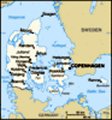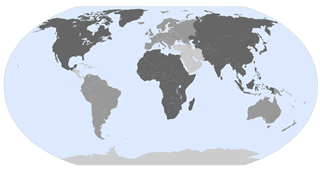Advertisement
Published: April 2nd 2020
The Saga Hotel at the Colbjørnsengade is just five minutes walking from the Central Station of Copenhagen. It is not expensive and surrounded by restaurants. Moreover it comes with a copious breakfast. It is situated in the Vesterbro area, once a red district. And still there are prostitutes around, like the Thai restaurant we visited. You just have to go downstairs into the basement and you are welcomed by a flock of Thai girls. We came for the food, the red curry and the masaman curry, our favourites. The Saga Hotel is on walking distance from the main musea of Copenhagen.
To come to the musea, you have to cross the train station, which has a nice hall full of shops and restaurants. At the other side is Tivoli, the playground for families, but now in winter an empty spot. After passing Tivoli area you come into the area where the musea are.
Each day we came back from our walks across the city, we settled down at the Jerbanecafeen (The Railroad Pub), opposite the station. It is a nice pub full with pictures of trains.There is even a little train going around. We were surprised to see you
make smoke in this pub. The people are very friendly. Ask for the value card. It is a train ticket. Every time you buy a beer, the barman will make a hole in your ticket with his perforator. Once you have 10 holes, you get a bronze medal, 20 makes a silver one and 30 a golden. The barman himself is very proud of having a golden medal. In four days we made it just in time to get a bronze medal. With a little ceremony the barman hung it around my neck. 'By the way, it is also a bottle opener', he said.
The Glyptoteket The Glyptoteket consists of several buildings. The main entrance is at the Dahlerup building, designed by Vilhem Dahlerup (1897). Actually it is the most beautiful building with its fin de siècle architecture. After passing the Winter Garden you enter the other buildings. We saw sculptures made by French artists like August Rodin and Jean Baptiste Carpeaux (La Danse, Why be borne a slave, Ugolino and his sons) and several Danish sculptors. Most impressing was the temporary exhibition, called 'The Road to Palmyra', in which Queen Zenobia plays a major role. Unfortunately many
buildings have been destroyed by IS, as the exhibition shows.
A nice restaurant near the Glypotkeket is the Ramen Restaurant at Tietgensgade. Specially the Bao Bun was tastfull.
The Rådhus We visited the Rådhus to see Jens Olsen's World Clock. But the clock was under construction. So we walked around a little, though there was not so much to see.
The House of Amber Museum Opposite the Rådhus is the House of Amber. It is a shop, where you can buy ornaments made of amber: bracelets, earrings and so on. They even have blue amber from the Dominican Republic. Very rare. Very expensive. To see more amber we walked through Frederiksbergade and Østergade to the Amber museum at Kongens Nytorv, where you can be astonished by the biggest piece of amber ever found. It weighs about 50 kilogram and it comes from Sumatra.
There are many myths about amber. Some say it are gallstones, dried urine of a lynx, tiger souls, mermaid tears or the tears of God. According to the Greeks the Sun god Helios allowed his son Phaethon to drive the sun across the sky. But his chariot went out of control, almost
scorching the earth. So Zeus had to kill him with a thunderbolt. He was cast in the river Eridanos. His seven sisters, the Heliades, mourned about him and kept vigil where he fell. Finally the gods transformed them in popular trees. Their tears changed to amber.
The Vikings believed that amber stones are the tears of goddess Freya, She cried because her husband was unfaithfull. Her tears became gold where they fell to land. When they fell in sea they became amber stones.
According to the Chinese amber stones are the souls of dead tigers. Amber is the symbol of courage in China.
But now we know better. Amber is the fossilised resin of conifers. The amber from Denmark is Baltic amber, the most common amber in the world. It is formed 30 - 50 million years ago from the now extinct Sciadopityaceae conifers. Once they covered large aereas of North Scandinavia, parts of Russia, the Norwegian sea and the Baltic sea. Then climate changed and the conifer forests were flooded. The prehistoric Eridanos (called after the old Greek river) and Alnarps rivers carried the amber stones to areas where you can find them today. We even found
them ourselves in the Netherlands on the Island of Schiermonnikoog. At the Amber museum we bought nice ear rings with amber stones.
Nyhavn and Slotsholmen Not far from Kongens Nytorv is Nyhavn with its colorful houses along the canal. At the opposite side is the house where Hans Christian Andersen used to live. We walked back to the Østergade, where we drank warm chocolate milk in the Chocolate Hotel and turned left at Højbro Plads to Slotsholmen, where the buildings of Christianborg Palace are and strange buildings like the Stock Exchange. Via the Royal Library in the Black Diamond building and the Frederiksholms Kanal we walked back to out hotel, but not without taking a beer of course in our favourite pub the Jerbanecafeen.
Restaurant Købyens Fiskebar is a famous fish restaurant in trendy Kødbyen, the Meatpacking District in Vesterbro. It is ten minutes walking from the Saga Hotel. Delicious indeed, but prices are (far too) high.
The Tycho Brahe Planetarium and the Rundetårn
Tycho Brahe is famous for the model he had made of the solar system. In this systeem he combined the Ptolemaeic and the Copernican system. In the first is the
earth in the middle, whith the sun and the planets orbiting around it. In the second one all planets circle around the sun. According to Tycho Brahe the planets go around the sun and the sun is orbiting the earth.
So we were eager to see the planetarium named after this famous astronomer, located at the corner of the Vester Søgade and the Gammel Kongevej It was a deception. There was just one little display about him somewehere in a dark corner. Nothing about the way Brahe used to see the solar system. Maybe the Danish don't want see that Brahe was mistaken? Despite this poor show about one of Denmark's great astronomers, we must admit that the planetarium have a nice exhibition on the universe. Besides there are 3D-movies about stellar world.
A better Brahe experience we had at the Rundetårn. The tower is located at the Købmagergade. It was built by King Christian IV between 1637 and 1642 as a platform for the university observatory. Tycho Brahe did there his obeservations. You can climb the tower via a spiral ramp. In the past people went to the top by horse, like tsar Peter the Great. Later
there were bicycle contests on bicycles with these big wheels in the front. There is hollow core, which was used as Denmark's geographical zaro point when mapping the country from the 1760s onwards.
Halfway the tower is a planetarium, made by Ole Rømer in 1697. The original one showed the sky according to Tycho Brahe. Later it was modified to show Brahe's solar system together with the one of Copernicus, with the sun in the center. The mechanism was damaged in 1728 by a fire. They rebuilt it with only the system of Copernicus. And that is what you see nowadays.
The Nationaalmuseet Actually our reason to visit Copenhagen was to see the National Museum, specially the exhibition on the Bronze Age ans even more specially to see Egtved Girl.The exhibtion on the Bronze Age is overwhelming indeed. Probably the best in Europe. All prehistory is represented, from Stone Age, via Cupper Age and Bronze Age up to Iron Age.
It is astonishing how many items the Museum has of the Bronze Age. We were busy during three hours, just to see the Bronze Age. It appeared that Denmark, specially Jutland, came up after the last
Ice age, after the heavy ice sheet withdrew. South of it the the land went down and disappeared. That is why so much has been found in Jutland.
The Egtved Girl was one of the items found. More than 3,300 years ago she travelled from the Black Forest in Germany to Denmark, where she died at the age of 16 - 18. She was buried in an oak coffin with her clothes and ornaments. The coffin has been found in the 1920s in the town of Egtved in Central Jutland. Everything was still there apart from her body, which disappeared because of the acid circumstances. Next to her was a little boy of about five year.
The Nationaalmuseet is only 15 minutes of the Saga Hotel. Nearby is a nice restaurant, called Karla with Danish specialities.
Advertisement
Tot: 0.098s; Tpl: 0.012s; cc: 9; qc: 23; dbt: 0.041s; 1; m:domysql w:travelblog (10.17.0.13); sld: 1;
; mem: 1.1mb























